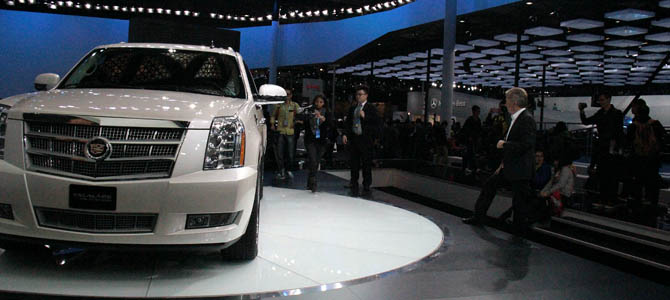After decades of slogans like “See the USA in Your Chevrolet” and “Baseball, Hot Dogs, Apple Pie and Chevrolet,” General Motors GM +1.27% has retreated from its overtly patriotic marketing approach since emerging from government-funded bankruptcy. Maybe that was a wise move, given that American taxpayers paid for the $50 billion bailout of “Government Motors” and not all of them were happy about it.
But another dynamic also seems to be at work: The auto maker has fundamentally shifted its focus. American taxpayers may have rescued GM during its moment of need, but it is China that is disproportionately benefiting from the bailout of America’s erstwhile automotive icon.
GM’s most recent round of investments vividly demonstrates the change. At last week’s Shanghai Auto Show, GM announced it would spend $11 billion on new production facilities in China by 2016, creating some 6,000 new jobs there. By contrast, GM has invested only $8.5 billion in U.S. operations since its 2009 bankruptcy, and since 2005 the number of workers it employs in North America has fallen by 76,000, according to the industry publication Automotive News.
At first glance, this seems little more than a function of China becoming the world’s largest auto market. But GM’s investments aren’t merely about meeting Chinese demand, which has actually slowed in recent years. According to statements to the press made by company officials at the Shanghai Auto Show, GM is targeting 100,000-plus exports of Chinese-made cars this year, a record, with export growth likely to be more than 50%.
Once merely an important growth market, China is fast becoming GM’s global export base, and the change can be seen in the very structure of the company. Before last year, GM’s vice president for global manufacturing was a North American-focused executive based in Detroit. Now the person holding that position is the president of GM’s international operations, overseeing the company’s ventures in China, Korea and Russia.
As the result of the company’s new emphasis, GM China President Bob Socia says that Americans “could very well” soon find Chinese-made GM cars on showroom floors. “There is no reason why we can’t be exporting to the [United] States,” he told a reporter for the website Autoblog at the Shanghai Auto Show.
But GM selling cars made in China at American dealerships probably isn’t what the federal government, in late 2008 under President Bush and then under President Obama, had in mind when it came to GM’s rescue. Last October, Mr. Obama chided Mitt Romney at a presidential debate by saying, “You know, if we had taken your advice, Gov. Romney, about our auto industry, we’d be buying cars from China instead of selling cars to China.”
Currently America is a net auto exporter to China, and Mr. Obama might even defend GM’s decision to shift resources to China by pointing out that America’s auto exports have risen since the bailout. But it isn’t the government bailout or green-technology loans that have fueled America’s car-making comeback; it’s broader trends in the global economy, most importantly a weak dollar combined with low U.S. interest rates.
Additionally, the U.S. is a net exporter only because Japanese, German and Korean auto makers with plants in the American Midwest and South are delivering units abroad. Several Japanese auto makers in the U.S., which abandoned Japanese production because of the high yen, say they will soon become net exporters from the U.S., hiring Americans to build cars for export even as “domestics” like GM move toward Chinese imports.
More than production jobs are at stake in GM’s headlong rush to embrace China. General Motors has also spent billions on technical, design and development facilities across China, including a joint advanced technical center and proving grounds outside Shanghai. Mr. Socia says the purpose of the building projects, like GM’s Chinese operations more broadly, is to “serve not just China but also GM’s operations around the world.”
At the new technical center near Shanghai, GM and its Chinese partners are jointly developing new cars based on GM components, including such high-tech elements as electric-car batteries, dual-clutch transmissions and lightweight materials.
GM’s technical cooperation with Chinese partners goes beyond what any of its major competitors are willing to risk in light of China’s reputation for intellectual-property theft, on top of government-mandated technology transfers. While lost manufacturing jobs are a common concern for Americans today, an even bigger problem down the road may be the erosion of America’s technical advantage and its effects on broader U.S. economic performance.
With GM’s technology and manufacturing jobs streaming into China even as other auto makers invest in the U.S., taxpayers might well wonder what their billions of bailout dollars really bought. Certainly the future that the Obama administration has promised—one of high-tech green cars designed and built by GM and Chrysler in America for export around the world—doesn’t seem to be forthcoming. Instead, GM has become what one might call America’s subprime auto maker, increasingly dependent on cheap credit, fueled by the Federal Reserve’s near-zero interest rate policy, to support its made-in-China production strategy.
Ultimately this new direction is less a problem for the administration, which is in the process of divesting its shares of “New GM” at a loss, than it is for General Motors. After decades of wrapping itself in Old Glory and campaigning against “import” brands, GM is becoming the new face of Chinese-made cars. If GM’s executives think the bailout made the company a political football, wait till they see what happens when American car buyers start finding “Made in China” tags on Chevrolets and Cadillacs.
This story from the SWWE (Stories We Wrote Elsewhere) archives appeared first on April 30, 2013 in the Wall Street Journal






